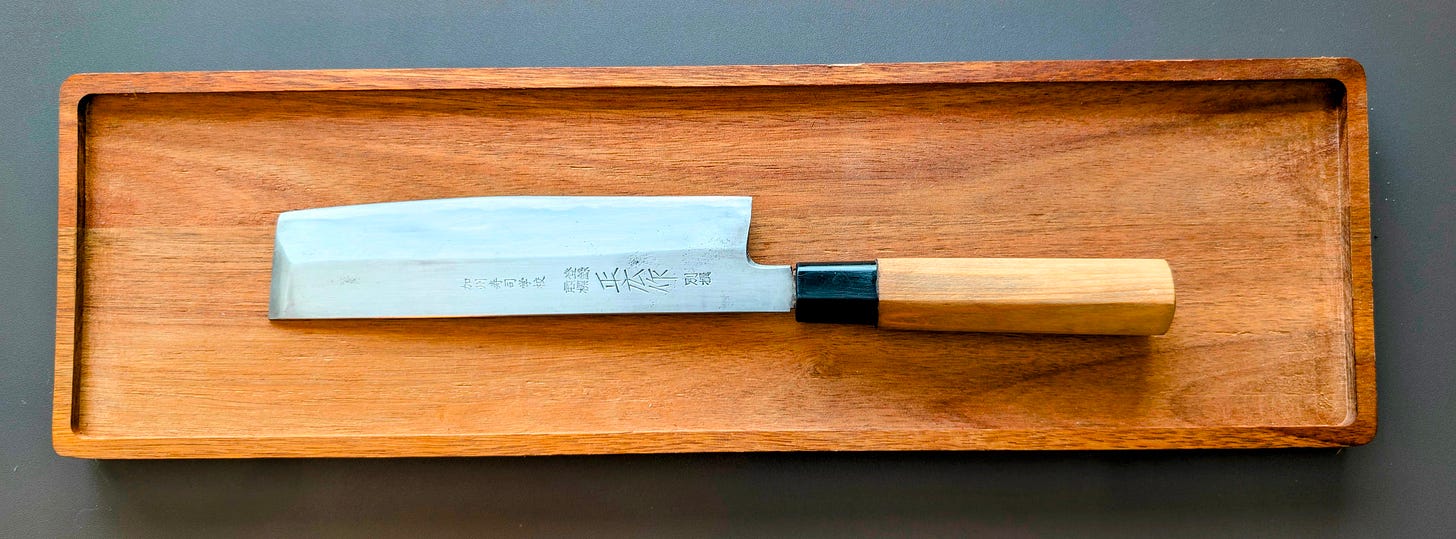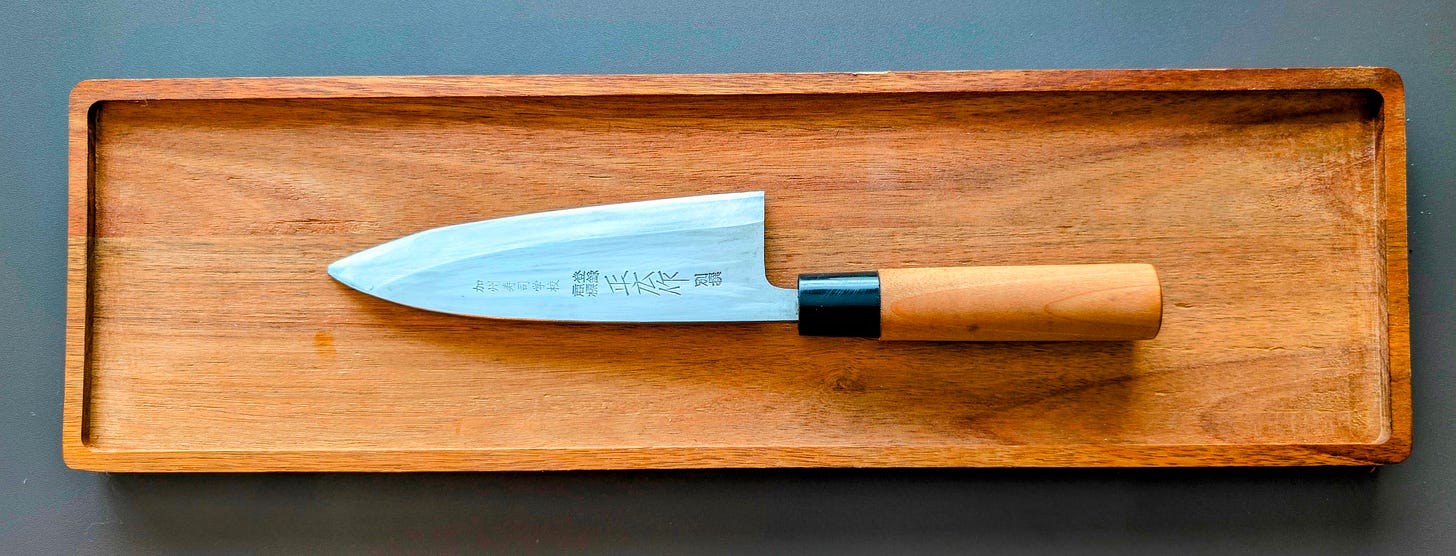Dear Sensei,
I remember the first time you showed me how to hold my yanagi. You said it wasn’t just a sushi knife, but an extension of my hand. A sacred tool that required precision, care, and reverence.
And I remember the day I realized I had lost it. I was standing on the sidewalk in front of the James Beard House, just hours before what felt like one of the most important dinner services of my life.
When our Memphis restaurant got the invitation to cook at the James Beard House, we were ecstatic. An invitation to “Beard House,” as we called it, was one of those special and, let’s be honest, clout-boosting things we chefs love to talk about. (To be clear, we weren’t receiving an award, just cooking dinner. But we were very excited all the same.)
As the head sushi chef of my boss’s restaurant group, I got to be part of the Beard House team. We had many meetings meticulously planning a menu with everyone contributing a course, refining flavors, and imagining the plates. But planning this dinner was about more than just about the food. It came with some serious logistics.
Sourcing ingredients in New York might’ve been possible, but between our tight travel schedule and a tight prep window, we didn’t want to risk it. So we hatched a plan that felt like equal parts hope and hustle:
Step One: Gather everything at our Memphis restaurant so we could track every last daikon and detail.
Step Two: FedEx overnight everything. Immediately realize we’re not made of money.
Step Two (Revised): Pack coolers like pros. Check them on our flight.
Step Three: Stash the coolers in walk-ins across NYC, thanks to our boss’s generous restaurant friends. (Unfortunately, no single kitchen had room for them all.)
Step Four: Jump in cabs on the big day. Each chef retrieve assigned set of coolers. Meet at the Beard House to prep.
To reward all of our planning and effort, our boss booked us at one of her favorite hotels: the Hotel Gansevoort. It the classic Meatpacking District vibes with the moody lighting, the impossibly cool furnishings, and the guests who looked like they’d stepped out of Fashion Week.
And then there was us….and all of our mismatched styrofoam coolers bound with duct tape. The staff took one look and made it clear that our duct-taped abominations clearly didn’t fit the aesthetic. The staff quickly had our coolers whisked out of sight.
The morning of the dinner moved fast. As planned, we split up to retrieve the ingredients scattered across the city. I was distracted yet energized by the beautiful busyness of New York. At my stop, the restaurant staff wheeled out a stack of coolers and helped me flag a cab. I made my way to the Beard House, so excited I could hardly stand it.
I was the first to arrive. One of our team members met me outside to help unload the coolers on the sidewalk. I stepped back and eyed the coolers proudly. Our plan had worked.
And then I froze. Something was missing. My knife case.
I peered down the street, but the cab was long gone. And with it my knives. My stomach dropped. I felt everything around me going dark. How was I supposed to prep sushi without them? Slice sashimi without my yanagi?
Beneath the panic, something deeper began to rise. Those knives weren’t just tools. They’d been with me since sushi school. I’d learned to sharpen them, cherish them, respect them.
They were memory. They were discipline. They were part of who I had become.
I stood there on the sidewalk, fighting back tears, quietly mourning. I didn’t hear the next cab pull up or notice the footsteps.
Then, gently, the pastry chef placed something by my foot. My knife case. I was in such a daze, I could barely respond. But the moment I saw it, relief poured over me like sunlight after a storm. I dropped to my knees, picked up the case, and cradled it like a baby.
And you’re probably wondering how the dinner went. It went well, just as we had planned. But if you ask what I remember most about that night, it’s not the dinner. Honestly, those details are still a blur. But what I do remember vividly is being on that sidewalk, cradling my knives again.
Somehow, that mattered more than anything. They weren’t just steel that night. They were every early morning, every late night, and every lesson learned. And holding them again reminded me that sometimes the thing that steadies us isn’t just skill or preparation. It’s remembering how much of ourselves we’ve already carried, already honed, and already survived.
Tools of the Trade: Japanese Sushi Knives
When people find out I’m a sushi chef, one of the first things they ask about is my knives. What kinds I have, whether they can hold them (Sorry, no!), and what goes into the maintenance.
My knives are definitely a point of pride, even if they are a little high-maintenance.
Japanese knives have a few key differences from Western-made chef knives. They’re crafted from carbon steel, which means they can rust without proper care. They’re sharpened on a whetstone, never honed like Western knives. And they’re sharpened on one side only.
If you’re a sushi enthusiast, you absolutely don’t need traditional Japanese knives to make beautiful sushi at home. The time required to sharpen, polish, and maintain them might be more than you bargained for.
But, they are well crafted and worth it if you don’t mind the extra maintenance. Here are the three I’ve loved and used for over 20 years.
Usuba, Vegetable Knife
If I had to choose a favorite, this would be it. The usuba makes nice, precise cuts for practically any vegetable cutting technique you can think of.
But I love it most for katsuramuki, that paper-thin peeling technique where a cylindrical vegetable is cut into one long continuous sheet under your blade.
In sushi school, we started practicing katsuramuki on day one. Every single day, there was time set aside just for it. Even now, I’ll pick up a length of daikon and see how thin, how long, how continuous I can make the cut.
Deba, Butchering Knife
The first time I picked up a deba, I remember thinking: this might be the most dangerous knife in my case. It’s traditionally used for fish butchery, and the weight alone was enough to make me double-check my grip. I was less worried about technique and more focused on not dropping it on my foot. Or worse, a finger.
Despite its heft, the deba can also make remarkably precise cuts.
These days, even though I’m not breaking down fish, this knife still finds its way into my rotation. It’s heavy enough to slice through a butternut squash, but refined enough to peel the skin away when I need it to.
Yanagi, Slicing Knife
When most people think of a classic sushi knife, this is THE knife. It’s used for sashimi and nigiri. It’s all about precision.
In sushi school, we were taught to cut rolls with the yanagi, too. Not an easy feat, since it’s sharpened on only one side. To make a clean, straight cut, you have to angle the blade just right. To this day, even when I use a straight-edged Western knife, my wrist still tilts slightly, as if I’m guiding a yanagi. And my sushi pieces come out with the faintest angle.
I don’t cut fish anymore, but when I’m preparing sushi in front of clients, I use my yanagi. The way it moves smoothly and deliberately through the ingredients is part of the experience.
Whether or not you ever pick up one of these knives, I hope this gave you a little insight into what goes into sushi beyond the ingredients. And if you do want to explore sushi knives for yourself, I highly recommend checking out Korin. They are a very reputable source.
Just don’t leave them in a New York cab!











What a lovely piece of writing. I think every chef has had at least one stomach-lurch moment when they realise a knife is missing. So glad you got yours back!
But I have to know how the knives ended up with the pastry chef?!!!